Our Favorite Artwork Under 10K from Frieze Art Fair’s Viewing Room
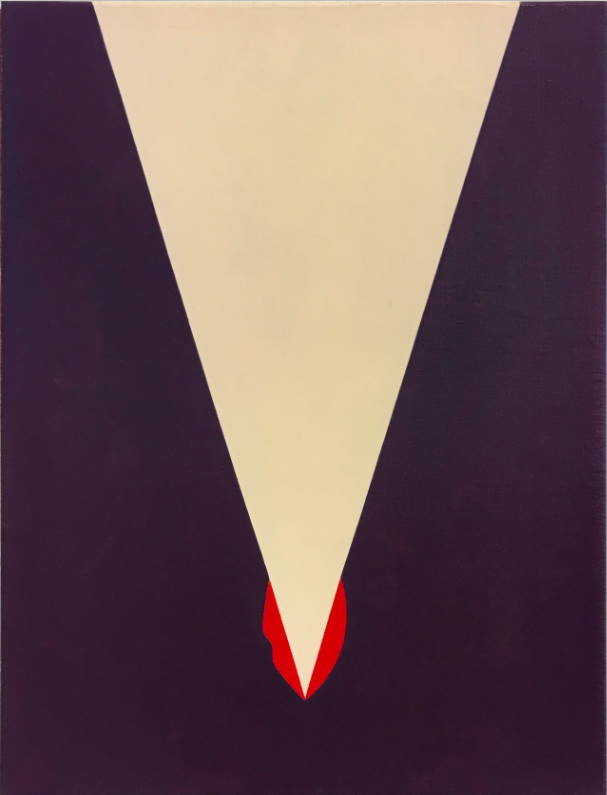
From May 8-15, Frieze has launched its ambitious new digital initiative featuring more than 200 galleries from across the globe and presenting major works by established and emerging artists for the first-ever online edition of Frieze New York.
Pros: Easily filtered price points, mediums, genders, and gallery locations. For new or shy collectors, the ability to inquire on a work is a simple click of a button, which can be easily accessible from the ease of your home, rather than feeling overwhelmed in a large crowded venue.
Cons: Not virtual enough. The thrill and the excitement of the VIP art world atmosphere is no more — diminishing the experience of seeing the size of artwork in person and the opportunity to gallivant and mingle with a stylish crowd.
Nevertheless, this year Frieze New York has over 1700 women and non-binary artists to browse through. If you’re a quarantined collector on a low budget, we put together a list of some of our favorite artwork priced under 10K.

ABOUT LILAC, 2007
19.25” X 31.5” (48.9 CM X 80 CM)
SCREENPRINT
EDITION 75
$ 7,800 ex-VAT
In 1965, English artists Bridget Riley exhibited at the Museum of Modern Art, New York, in a group show, The Responsive Eye. The exhibition drew worldwide attention to the ‘Op Art’ movement, and Riley’s work which consisted of black and white geometric patterns. Riley’s printmaking over the last 50 years has run parallel to the developments in her painting. Riley worked exclusively in black and white until the late 1960s when she shifted her palette to grey and then to colour. (Cristea Roberts Gallery)

100 HAND-DRAWN MAPS OF MY COUNTRY (CUENCA), 2008
22.64” X 30.12” (57.5 CM X 76.5 CM)
TRACINGS ON PAPER
EDITION 6
Shilpa Gupta’s ‘100 Hand-Drawn Maps of My Country’ series draws us into the complexities of the construction and delineation of space articulated by man-made borders. The drawing features numerous representations of the country’s map, drawn from memory by 100 people of that particular country. The variety of forms produced throws into question how political borders are created, imagined and learned. A highly subjective interpretation of the territory of a nation sees states skipped or incorporated with the attitude of each author. The work is made in times where the identity of the nation state has been emphasized and the relationship between an individual and the imagined state is ambivalent. (Vadehra Art Gallery)
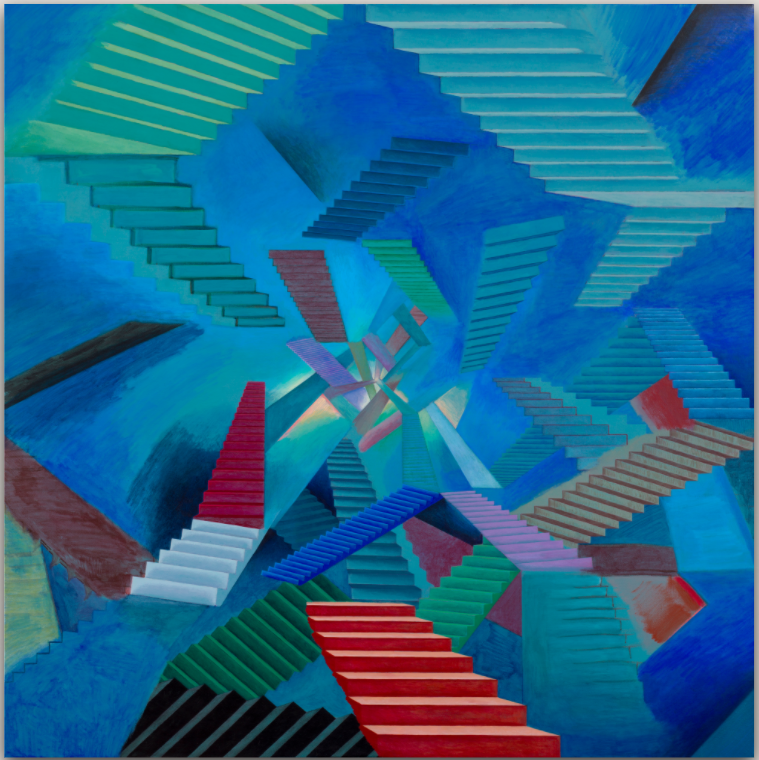
A PERSON FROM THE SKY, 2019
39.37” X 39.37” (100 CM X 100 CM)
ACRYLIC ON CANVAS
$ 9,500
The painting, ‘A Person from the Sky’ (2019), belongs to the series incorporated in Gao Yuan‘s latest animation, ‘Cloud of the Unknown’. The painting gravitates towards the atmospheric, with finer brushstrokes and brighter hues. Ascending and descending staircases depict a world in which normal laws of gravity do not apply, guiding us into another of Gao’s surreal scenes. (Capsule Shanghai)

A REAL TORTURE WOULD BE FROM INFLAMMATORY ESSAYS 1979 – 1982, 1993
17.13” X 17.13” (43.5 CM X 43.5 CM)
OFFSET LITHOGRAPH ON COLOURED PAPER (PINK)
EDITION 10 SHEETS + UNLIMITED APS
$550
Jenny Holzer is internationally known for her text-based works that interrogate the effects of rhetoric. Holzer initially rose to fame in the 1980s as part of a generation of outstanding feminist artists including Barbara Kruger, Louise Lawler and Cindy Sherman. The impactful texts that make up Inflammatory Essays spotlight Holzer’s ongoing concerns with power, social control, abuse, consumption and sex. The assertive and demanding statements are as biting and painfully prescient today as when they were first produced between 1979 and 1982. The essay offered here was originally created for the ICA in 1993 and epitomises Holzer’s indelible mark and unique voice. Jenny Holzer (b. 1950, Hoosick Falls). Recent solo exhibitions include GAMeC, Bergamo (2019), Guggenheim Bilbao (2019), Tate Modern Artist Rooms (2018), Blenheim Palace (2017) Hauser & Wirth Zurich (2017), Dorotheum London (2017), MASS MoCA (2017). Holzer became the first woman to represent the United States at the Venice Biennale in 1990 where she received the Golden Lion. (Institute of Contemporary Arts (ICA))
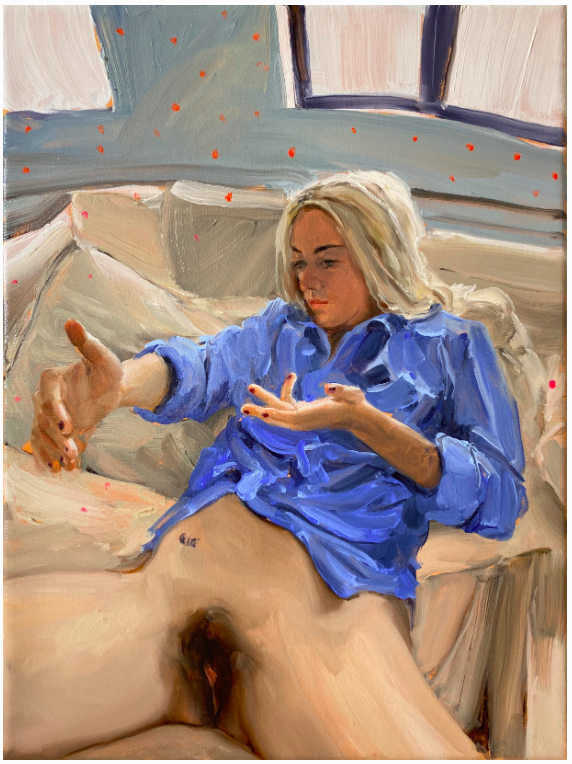
A SIMPLE DEMONSTRATION, 2020
16” X 12” (40.64 CM X 30.48 CM)
OIL ON LINEN
“This painting is a nod to Courbet’s L’Origine du monde, but with more of an identity than that artist’s headless torso. It’s also a painting about the complexity of trying to convey a simple thing, especially when it comes to depicting a woman’s body.” (Jenna Gribbon, Fredericks & Frieser)
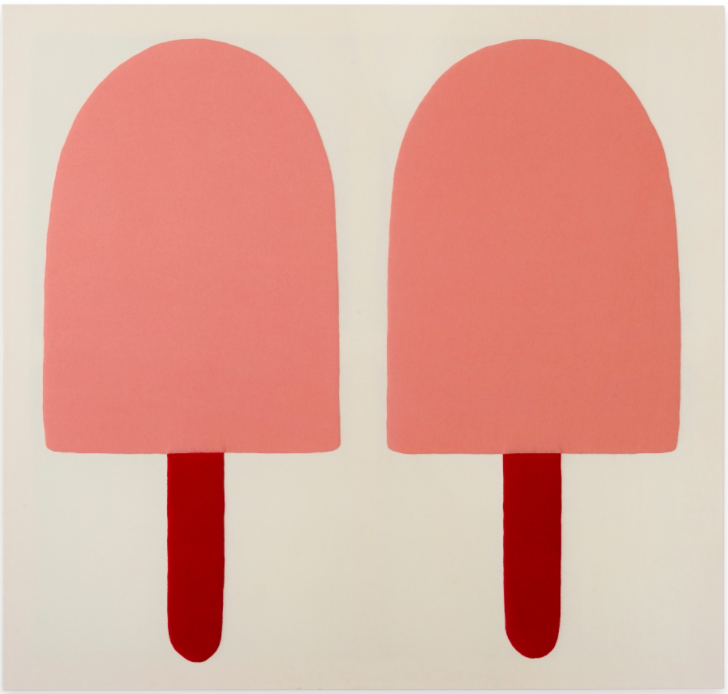
P420 GALLERY
GO EASY ON ME, TWO PINK ONES WITH RED STICKS
55.91” X 59.06” (142 CM X 150 CM)
WOOL STITCHED ON CANVAS
EDITION UNIQUE
$10,000
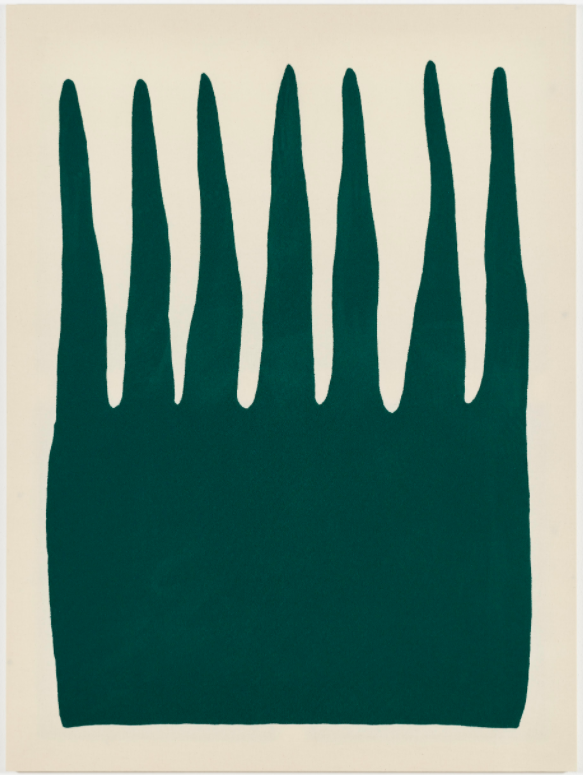
P420 GALLERY
AB OVO. GREEN PALM, 2020
62.2” X 46.46” (158 CM X 118 CM)
WOOL STITCHED ON CANVAS
EDITION UNIQUE
$7,200
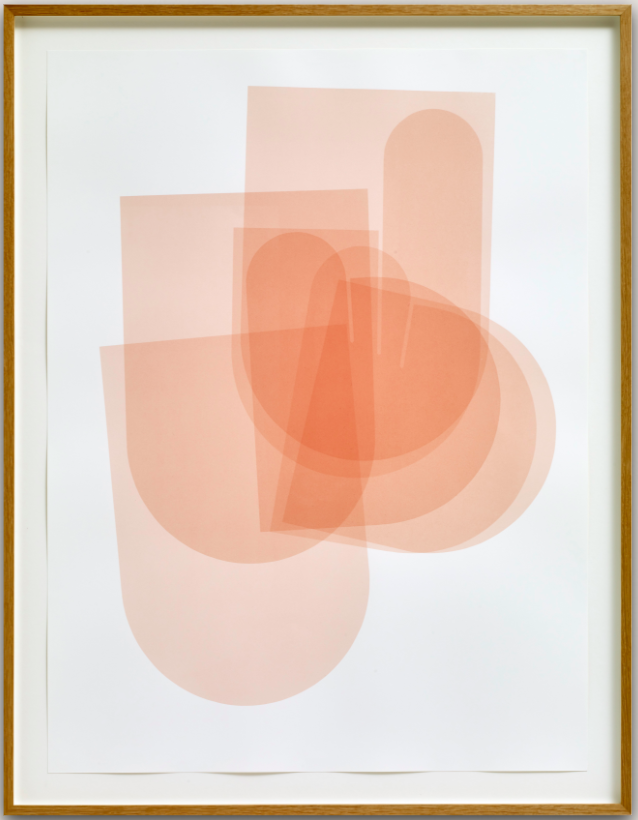
ALL OVER AND OVER 3, 2015
44.88” X 34.65” (114 CM X 88 CM)
UNIQUE SCREENPRINT ON SOMERSET SATIN PAPER
EDITION UNIQUE
£ 3,000
“I see a correlation between the way I make sculpture and the way I have developed my technique of screen printing. In both instances I am working intuitively without a design but with a tight control of the medium. The use of solid colour … the use of layering, the relationship of one shape to another, are in common with both practices. The placement of shapes on the page is like arranging objects in space and the production of a series of printed images like the related elements in my installations.” (Claire Barclay, Stephen Friedman Gallery)

AMERICAN SAMPLER, 1969
22.52” X 11.5” (57.2 CM X 29.2 CM)
SCREENPRINT
$6,000
‘American Sampler’ is one of twenty-nine prints in Corita’s heroes and sheroes series. The red, white, and blue work summons kitsch Americana, linking Kent’s stamped tract to an earlier form of handmade lettering. A sampler is a piece of needlework that served as the primary display of female literacy in the colonial and antebellum periods. Within an elaborate decorative scheme, samplers featured stitched inscriptions professing feminine virtue or, during the Revolution, patriotic zeal. (Andrew Kreps Gallery)

AN INDEPENDENT WOMAN FROM THE SERIES WOOD STREET LIBRARY, 2019 (“SORTED BOOKS” PROJECT, 1993- ONGOING), 2019
13.78” X 20.08” (35 CM X 51 CM)
C-PRINT
EDITION 8 + 2 AP
$3,800
For her Sorted Books series (ongoing since 1993), Nina Katchadourian engages with library collections, both private and public, selecting volumes and creating groupings where titles can be read as a whole. The resulting works point to through-lines in collections, making incisive and thought-provoking inferences about each library’s particular focus, omissions, or idiosyncrasies. (Pace Gallery)
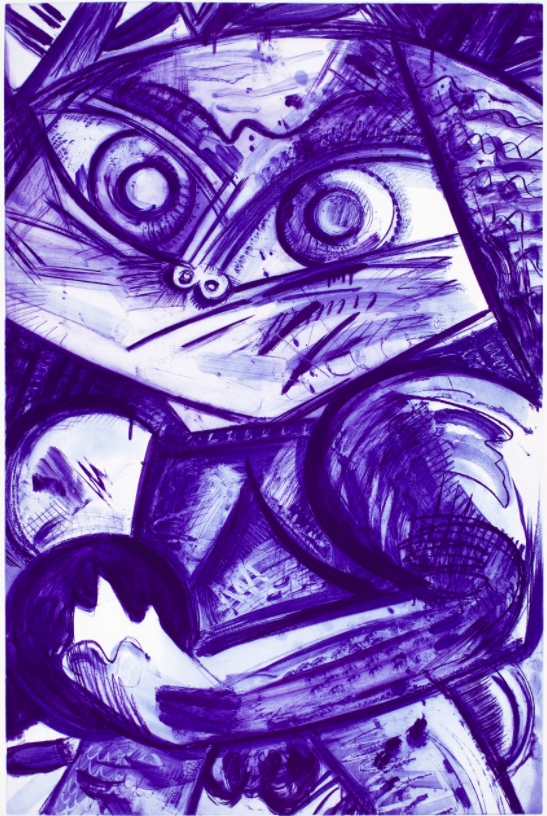
BOWLER, 2020
42.52” X 29.92” (108 CM X 76 CM)
ETCHING WITH AQUATINT IN TWO COLOURS
EDITION 30
£5000
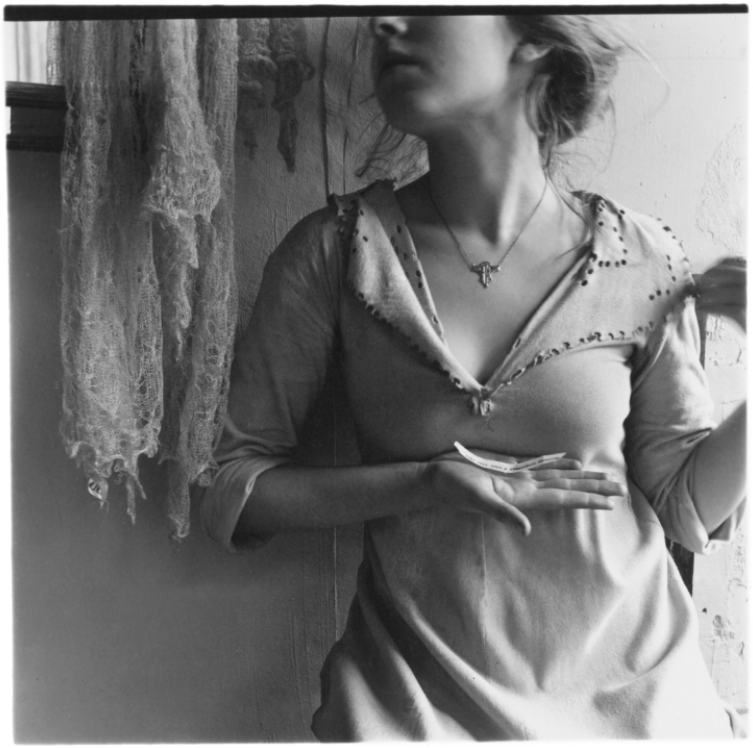
AND I HAD FORGOTTEN HOW TO READ MUSIC, 1976
10” X 7.99” (25.4 CM X 20.3 CM)
GELATIN SILVER ESTATE PRINT
EDITION 5/40
$ 6,500.00 (ex tax)
In her short career Francesca Woodman (1958–1981) produced an extraordinary body of work acclaimed for its singularity of style and range of innovative techniques. From the beginning, her focus was on the relationship with her body as both the object of the gaze and the acting subject behind the camera. And I had forgotten how to read music, 1976, depicts the artist, her head, which is partly cropped out of view, turned towards a high window covered with a lace curtain. In her right hand she holds a slip of paper. It is one of a number of works from this time that relate to music, linking photography with piano playing, one medium with another. Woodman had played the piano during her childhood and the title of this work is taken from a longer poem that Woodman had written in her first year of college at Rhode Island School of Design. A sequence of three images were presented together in the exhibition at and catalogue for On Being an Angel, organised by Moderna Museet, Stockholm. (Victoria Miro Gallery)

CATHY, 2011
12” X 15” (30.48 CM X 38.1 CM)
MARKER ON COLORED VELLUM
$5,000
Since the 1980’s, Kathe Burkhart has engaged gender roles, sexuality, celebrity, language, Pop Art imagery and assemblage to deal with the visual and verbal articulation of the radical female subject. (Frederick & Frieser)
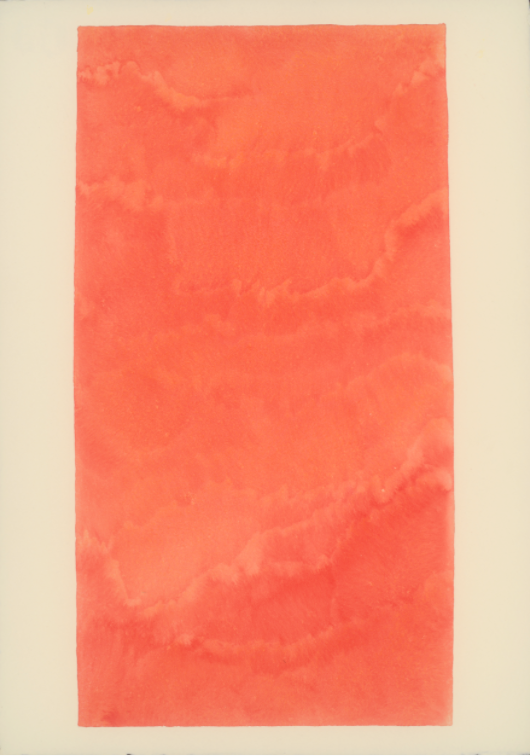
PM8 GALLERY
FOOL #RED1, 2015
137.8” X 59.06” (350 CM X 150 CM)
PAPER PRINT
EDITION 3
€ 9.000 / $ 9.700

FREDERICKS & FREISER
FEVER CHEEKS, 2020
16” X 12” (40.64 CM X 30.48 CM)
OIL ON LINEN

BUSTO SALSICHA, 2019
28.35” X 19.69” X 2.76” (72 CM X 50 CM X 7 CM)
ELASTANE, SILICONE FIBER, SEWING THREAD, FABRIC, FELT, VELVET AND STRETCHER
Yuli Yamagata’s universe is impregnated with multi-colored, popular, synthetic fabrics sewn and stuffed together. The artist treats fabrics that mimic other materials with humor, pointing to a way of being in the world in which reality and fantasy are interchangeable. Body parts such as mouths, eyes and organs are recurring images. Busto Salsicha (2019), composes an uncanny picture, with displaced and exposed organs. (Fortes D’Aloia & Gabriel)
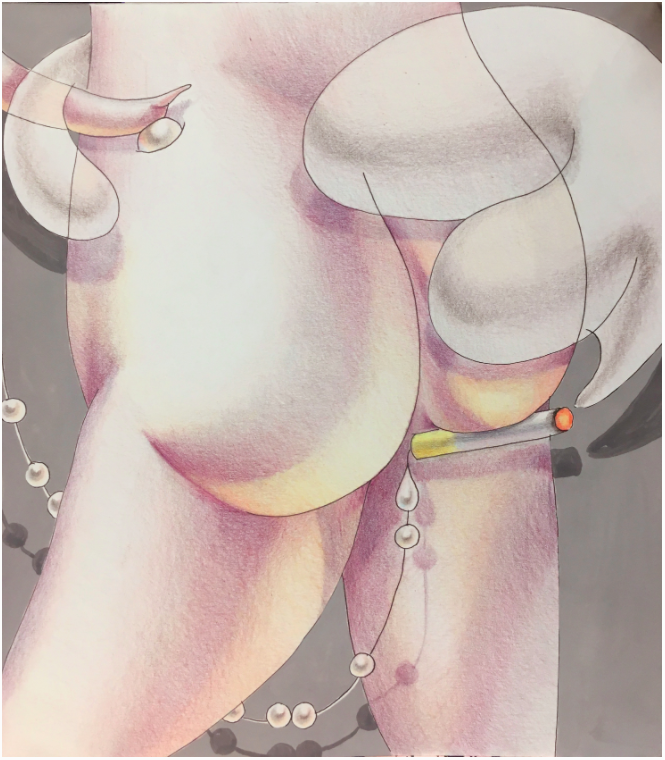
CIGARETTE AND BUM, 2020
12.6” X 11.02” (32 CM X 28 CM)
COLORED PENCIL, GOUACHE AND INK ON PAPER; FRAMED
The paintings of Sarah Slappey contort expectations of the female nude in ways that eroticize the distasteful and brutalize the sensual. Sexual puns and bathroom jokes are squeezed into compositions of fleshy surreality that bulge and squirt within the picture frame. Feminine symbols and phallic objects from tampons to pearls, cigarettes and lipstick are reframed as kinky props of evolved bodies condensed to sexual features. In doing so, Slappey seeks to topple a history of male dominated female depiction, taking control of an invented body of imagery, while translating its ability to remain provocative and sensuous. (Maria Berheim Gallery)

DICK IN A HEAD / FLOCKED PINK, 2013
27.56” X 19.69” (70 CM X 50 CM)
SILKSCREEN WITH FLOCKING
EDITION 50 + 5AP
$750
Judith Bernstein creates expressive drawings and paintings that boldly critique militarism and machismo in a manner that is at once humorous and threatening. Referencing the subliminal, Bernstein’s work is a psychological amalgamation of sex, war and feminism in different orders and priorities. For this edition, Judith Bernstein made her first flocked print since the 1970s. The print, entitled Dick in a Head, derives from an on-going series of drawings that refer to the idea that sex is in the head. (Institute of Contemporary Arts (ICA))

DOLLFACE, 2016
5.51” X 7.99” (14 CM X 20.3 CM)
ACRYLIC ON PAPER
Under $10k

DYKE, 2016
5.51” X 7.99” (14 CM X 20.3 CM)
ACRYLIC ON PAPER
Under $10k
Betty Tompkins (b.1945) has been celebrated and scorned for her provocative feminist iconography. A pioneering artist, Tompkins is best known for her direct depictions of the female body, sexuality, and sexual desire. In 2002 and 2013, Tompkins circulated the following email: “I am considering doing another series of pieces using images of women comprised of words. I would appreciate your help in developing the vocabulary. Please send me a list of words that describe women. They can be affectionate (honey), pejorative (bitch), slang, descriptive, etc. The words don’t have to be in English but I need as accurate a translation as possible. Many, many thanks, Betty Tompkins.” The response was overwhelming, with over 3,500 words and phrases in seven languages submitted, equally split between men and women. (PPOW Gallery)
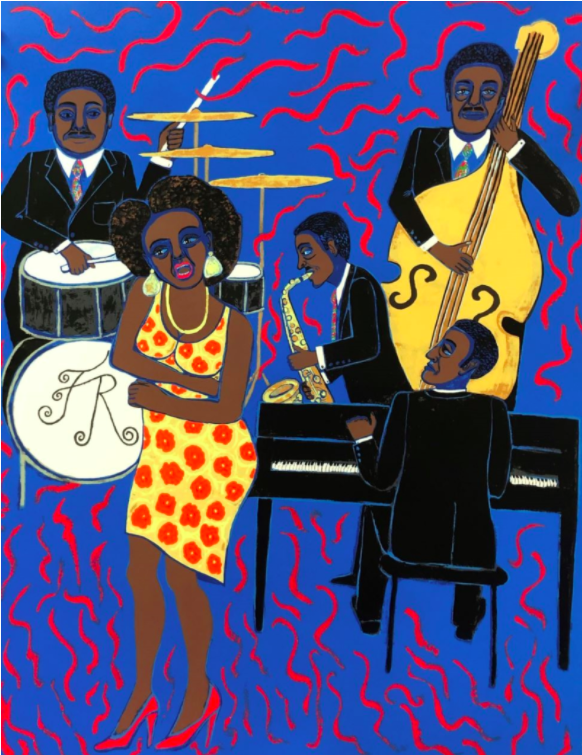
JAZZ STORIES: MAMA CAN SING PAPA CAN BLOW #8: DON’T WANNA LOVE YOU LIKE I DO, 2007-2020
29.92” X 24.8” (76 CM X 63 CM)
13-COLOUR SILK SCREEN PRINT ON COVENTRY RAG 335GSM
EDITION 100
£1,020/ £850 ex VAT
This new limited edition print follows Faith Ringgold’s acclaimed survey exhibition at the Serpentine Galleries in 2019 – the artist’s first in a European institution which included paintings, political posters and story quilts from the past six decades. The image of a singer and her band in this large 13-colour screen print originates from Ringgold’s Jazz Stories series of quilts which she begun in 2004. In this body of work, Ringgold looks back to Harlem and the vibrant legacy of jazz. Growing up in the creative and intellectual context of the Harlem Renaissance, Ringgold’s life has been surrounded by jazz musicians, many of whom continue to inspire her practice. (Serpentine Galleries)

NICELLE BEAUCHENE GALLERY / RACHEL UFFNER GALLERY
WARP, 2020
18” X 15” (45.72 CM X 38.1 CM)
OIL ON CANVAS
UNDER $10K

EMBAJADA GALLERY
MAGICIAN PYRAMID, 2020
20.08” X 16.14” (51 CM X 41 CM)
PHOTOCOPY MONOPRINT ON WAX PANEL
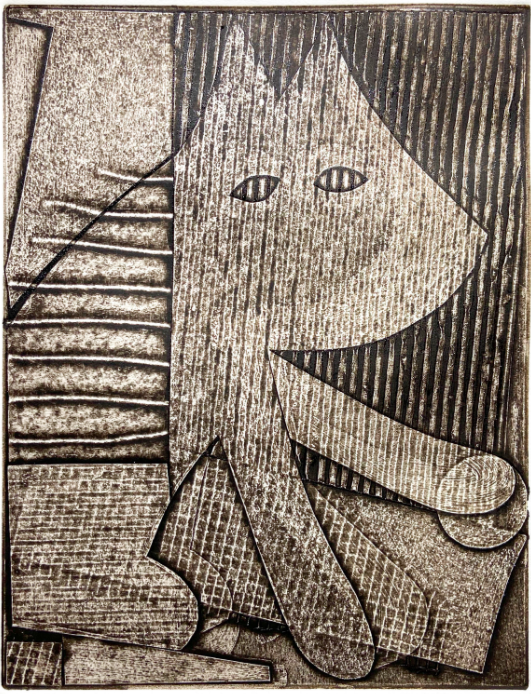
FILO, 2020
17” X 13.25” (43.18 CM X 33.66 CM)
COLLAGRAPH
EDITION 30
$1400
These works are developed on the occasion of Ulrike Müller’s new commission for the Queens Museum’s Large Wall, The Conference of the Animals, currently on pause during the Museum’s temporary closure. The Conference of the Animals takes its title from German writer Erich Kästner’s children’s book The Animal’s Conference (1949) written in the aftermath of WWII. The story is a political satire about a group of animals who, frustrated by the inefficacy of human international conferences, convene to save the planet. In her enamel paintings, woven wool rugs, and works on paper, Müller’s seemingly abstract vocabulary of colors and shapes is emotionally and politically charged, and encourages figurative readings. (Queens Museum)
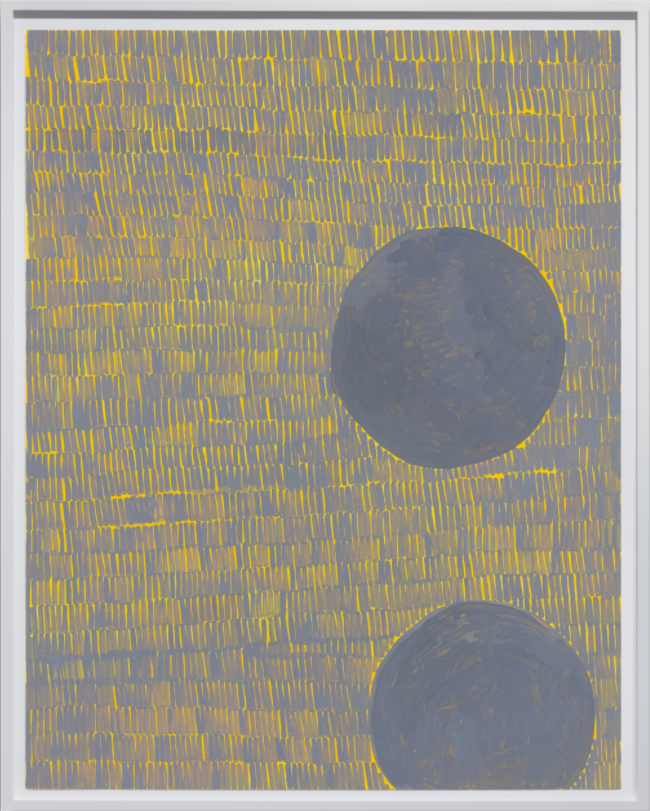
SEAN KELLY GALLERY
PAYNE 106 (C-19), 2020
25.67” X 20.63” X 1.38” (65.2 CM X 52.4 CM X 3.5 CM)
OIL ON BRISTOL
$5,000 + frame
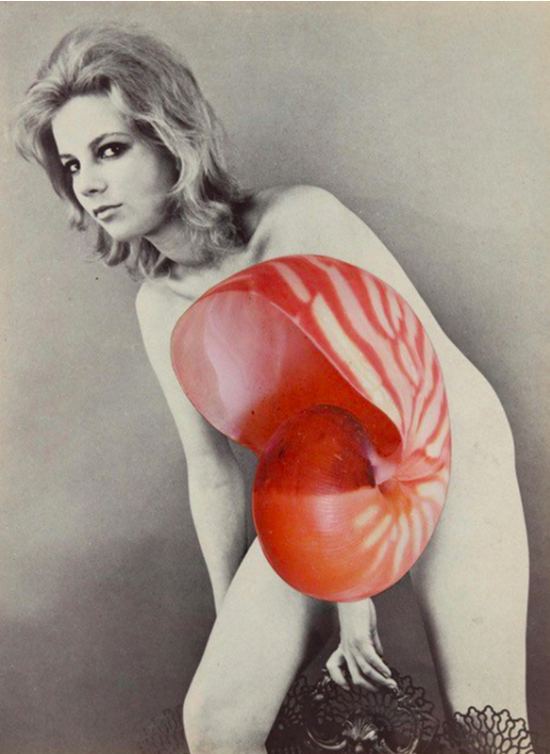
NOTTINGHAM CONTEMPORARY
PORTRAIT OBTAINED BY TELEPATHY, 2018
7.87” X 10.83” (20 CM X 27.5 CM)
DIGITAL PIGMENT PRINT WITH PHOTO COLLAGE
EDITION 30
£550/ £458.33 ex VAT

PRINTED MATTER, INC.
TIME, 2017
36” X 36” (91.44 CM X 91.44 CM)
SIX-COLOR SCREEN PRINT
EDITION OF 50. SIGNED AND NUMBERED.
$1500 (unframed)

DEREK ELLER GALLERY
PURPLE BEAST, 2017
40” X 32” (101.6 CM X 81.28 CM)
OIL ON CANVAS
$8,000

BRADLEY ERTASKIRAN GALLERY
SLEEPY SOLO, 2020
36” X 30” (91.45 CM X 76.2 CM)
OIL ON CANVAS
Under $10k
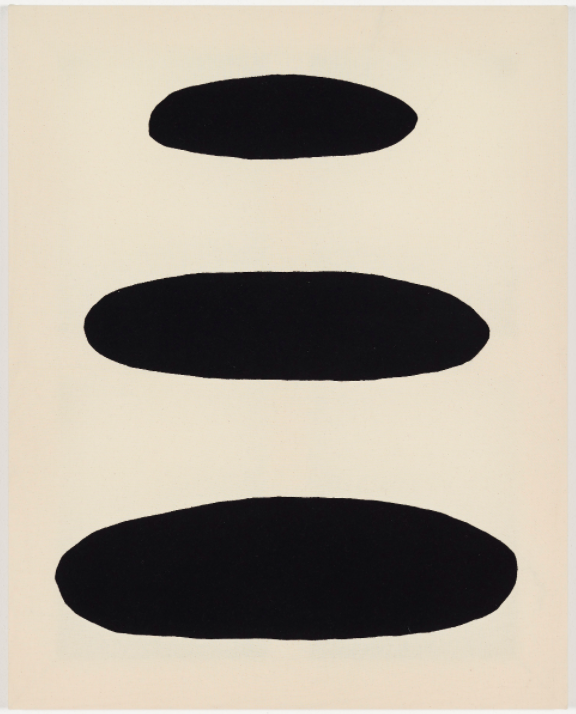
P420 GALLERY
THE BLACK HOLES, NUMBER 3 , 2020
40.55” X 33.07” (103 CM X 84 CM)
WOOL STITCHED ON CANVAS
EDITION UNIQUE
$6,000

BREEDER GALLERY
UNTITLED (WOMAN ON CHAIR), 2018
31.5” X 21.65” (80 CM X 55 CM)
INKJET PRINT
EDITION OF 5 +1AP
$4,500

MICROSCOPE GALLERY
BROWN, CARMINE, AND BLUE. II, 2018
24.02” X 32.01” (61 CM X 81.3 CM)
ARCHIVAL PIGMENT PRINT
EDITION 3 + 1 AP
$4,000
The photographic self-portrait “brown, carmine, and blue. II” shot in 2017, features the artist posing with a Ghanaian mask. This work points to the dual nature of the mask to both obscure and reveal, and it is unclear as to whether the artist is in the process of removing or placing it on her face. LeSeur also employs the object as a symbol for the shedding of the figurative masks put forth to assimilate and the embracement of her West African heritage in what she refers to as a process of “birthing a new identity unearthed from within.” (Microscope Gallery)

ANDREW KREPS GALLERY
WITH LOVE TO THE EVERYDAY MIRACLE, 1967
22.99” X 35” (58.4 CM X 88.9 CM)
SCREENPRINT
$6,500
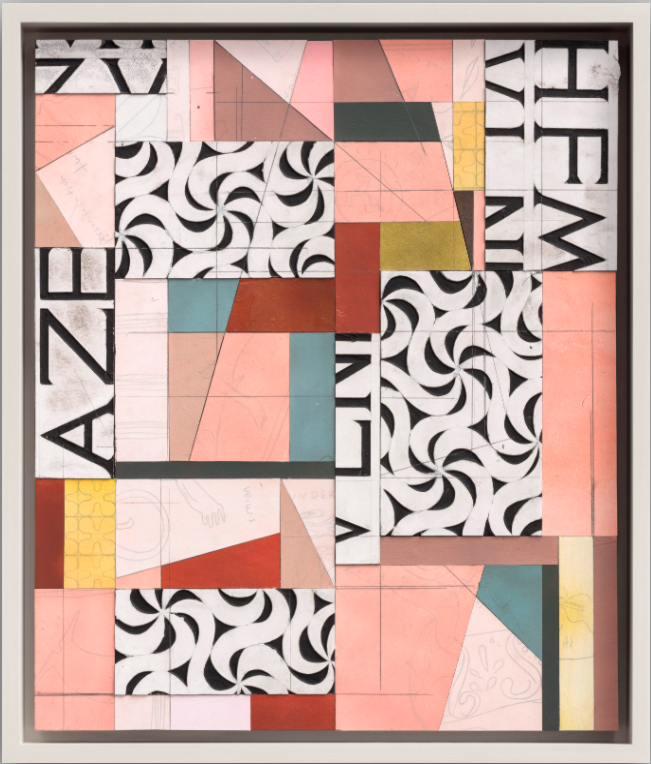
NO TITLE (GOLD, RUST, AND SWIRL SWATCHES), 2020
18” X 15.5” (45.72 CM X 39.37 CM)
ACRYLIC PAINT, ACRYLIC RESIN, PAPER, GLUE, AND GRAPHITE ON PANEL
$ 7,500

NICELLE BEAUCHENE GALLERY
NO TITLE (PINK AND PEACH SHAPES), 2020
18” X 15.5” (45.72 CM X 39.37 CM)
ACRYLIC PAINT, ACRYLIC RESIN, PAPER, GLUE, AND GRAPHITE ON PANEL
$ 7,500
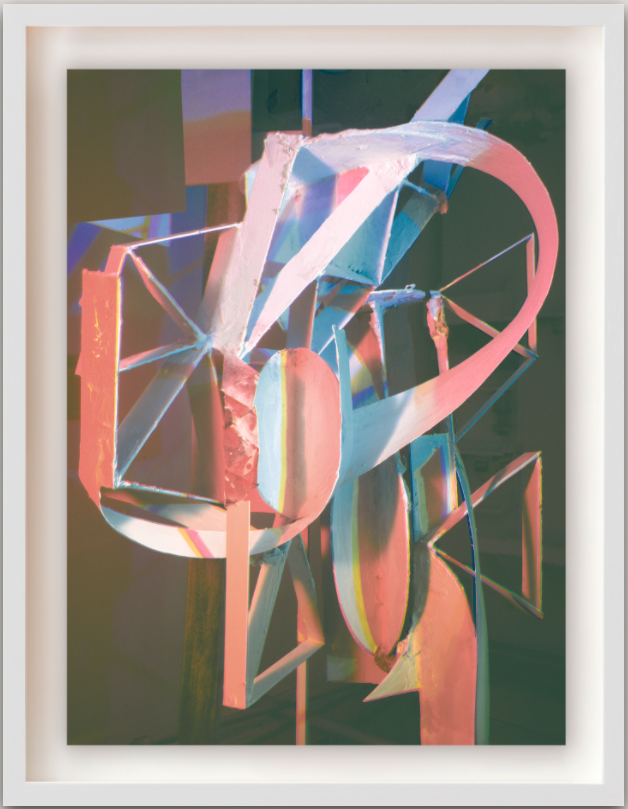
BEGINNERS MIND, 2020
44.72” X 34.72” (113.6 CM X 88.2 CM)
C-PRINT
EDITION 3 OF 5
$6000

TEMNIKOVA & KASELA GALLERY
BATH FOR THE VULTURE, FILLED WITH MEMORIES, MY LAST, 2019
24.02” X 17.72” (61 CM X 45 CM)
OIL, ACRYLIC, CANVAS
€5500 / $6000


